A Comparative Analysis of Oracle's Incentive Systems
VerifiedAdded on 2020/05/04
|12
|3319
|463
Report
AI Summary
This report provides an insightful analysis of Oracle's incentive systems, focusing on how they harmonize organizational performance across different cultural contexts. The study examines Oracle's incentive compensation program, particularly its application in Canada and Singapore, highlighting the differences in approach based on cultural nuances. It explores how Oracle uses incentive systems to improve sales alignment, operational effectiveness, and financial control, while addressing challenges related to global employee management and cultural diversity. The research includes an examination of financial and non-financial incentives, and discusses the significance of understanding employee perceptions to enhance job satisfaction. The report also touches upon the adoption of cloud-based technologies and the development of employee reward systems to motivate employees in Singapore. The study emphasizes the importance of flexibility and adaptability in managing global workforces and aligning sales behavior with corporate goals. The report concludes that effective incentive systems, tailored to cultural contexts, are essential for fostering employee commitment and achieving organizational objectives.
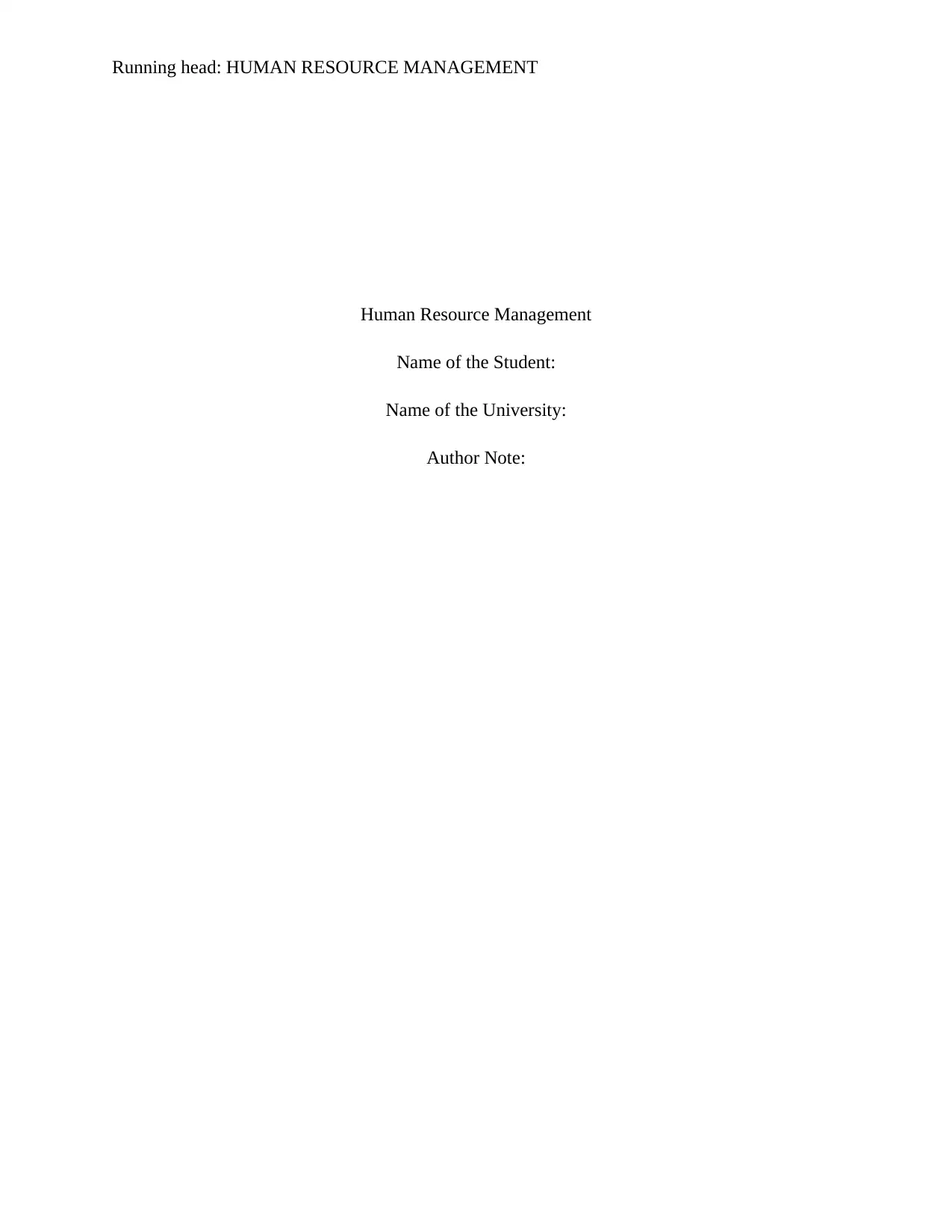
Running head: HUMAN RESOURCE MANAGEMENT
Human Resource Management
Name of the Student:
Name of the University:
Author Note:
Human Resource Management
Name of the Student:
Name of the University:
Author Note:
Paraphrase This Document
Need a fresh take? Get an instant paraphrase of this document with our AI Paraphraser
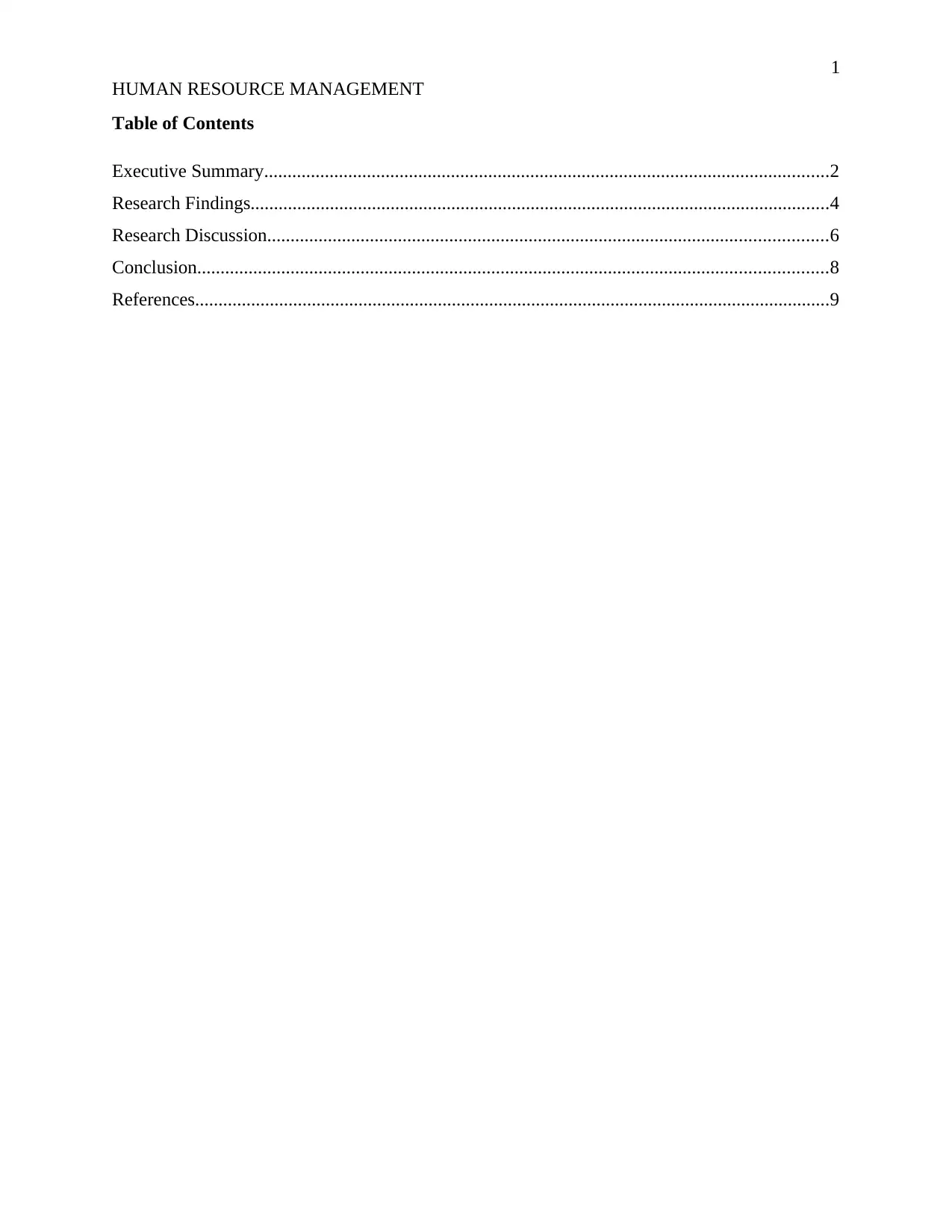
1
HUMAN RESOURCE MANAGEMENT
Table of Contents
Executive Summary.........................................................................................................................2
Research Findings............................................................................................................................4
Research Discussion........................................................................................................................6
Conclusion.......................................................................................................................................8
References........................................................................................................................................9
HUMAN RESOURCE MANAGEMENT
Table of Contents
Executive Summary.........................................................................................................................2
Research Findings............................................................................................................................4
Research Discussion........................................................................................................................6
Conclusion.......................................................................................................................................8
References........................................................................................................................................9
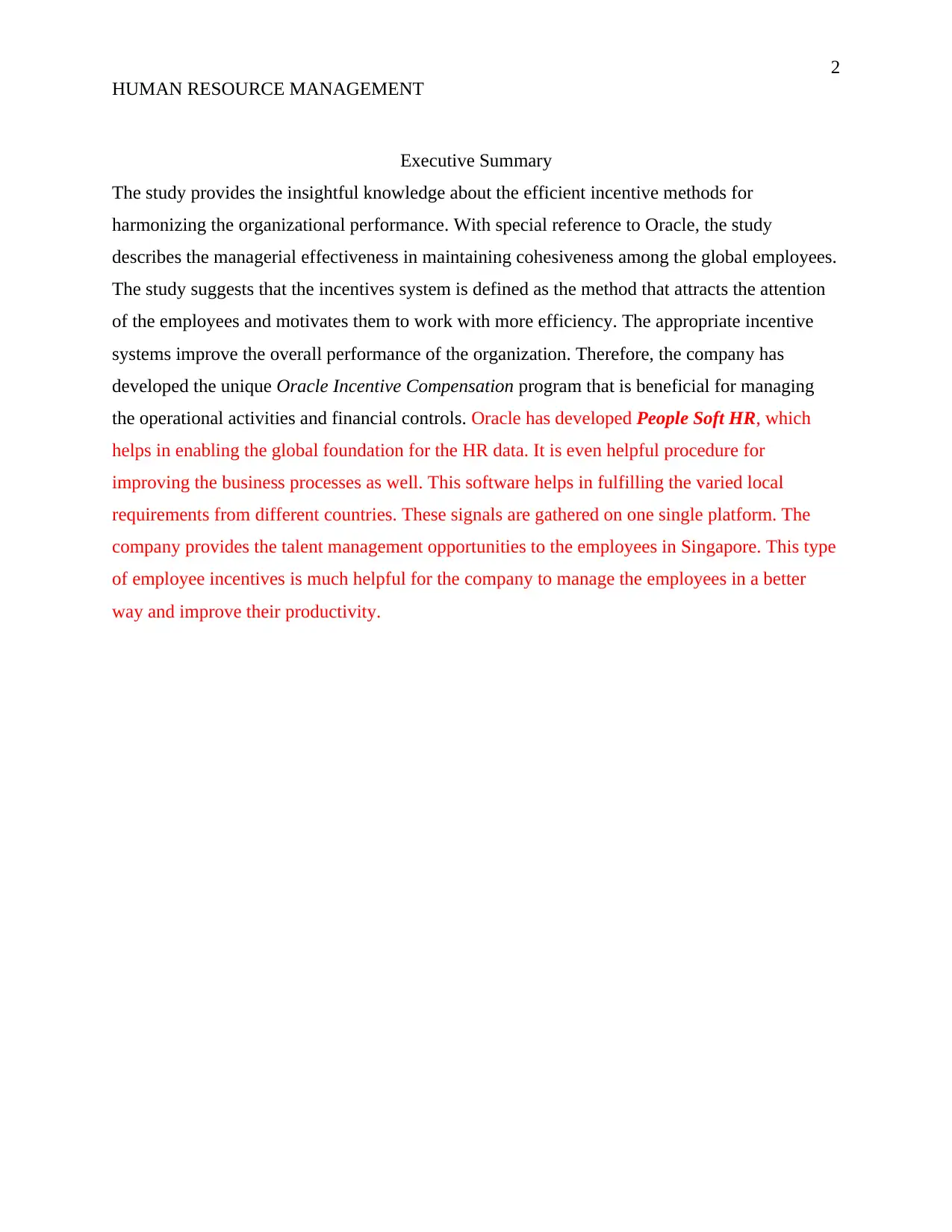
2
HUMAN RESOURCE MANAGEMENT
Executive Summary
The study provides the insightful knowledge about the efficient incentive methods for
harmonizing the organizational performance. With special reference to Oracle, the study
describes the managerial effectiveness in maintaining cohesiveness among the global employees.
The study suggests that the incentives system is defined as the method that attracts the attention
of the employees and motivates them to work with more efficiency. The appropriate incentive
systems improve the overall performance of the organization. Therefore, the company has
developed the unique Oracle Incentive Compensation program that is beneficial for managing
the operational activities and financial controls. Oracle has developed People Soft HR, which
helps in enabling the global foundation for the HR data. It is even helpful procedure for
improving the business processes as well. This software helps in fulfilling the varied local
requirements from different countries. These signals are gathered on one single platform. The
company provides the talent management opportunities to the employees in Singapore. This type
of employee incentives is much helpful for the company to manage the employees in a better
way and improve their productivity.
HUMAN RESOURCE MANAGEMENT
Executive Summary
The study provides the insightful knowledge about the efficient incentive methods for
harmonizing the organizational performance. With special reference to Oracle, the study
describes the managerial effectiveness in maintaining cohesiveness among the global employees.
The study suggests that the incentives system is defined as the method that attracts the attention
of the employees and motivates them to work with more efficiency. The appropriate incentive
systems improve the overall performance of the organization. Therefore, the company has
developed the unique Oracle Incentive Compensation program that is beneficial for managing
the operational activities and financial controls. Oracle has developed People Soft HR, which
helps in enabling the global foundation for the HR data. It is even helpful procedure for
improving the business processes as well. This software helps in fulfilling the varied local
requirements from different countries. These signals are gathered on one single platform. The
company provides the talent management opportunities to the employees in Singapore. This type
of employee incentives is much helpful for the company to manage the employees in a better
way and improve their productivity.
⊘ This is a preview!⊘
Do you want full access?
Subscribe today to unlock all pages.

Trusted by 1+ million students worldwide
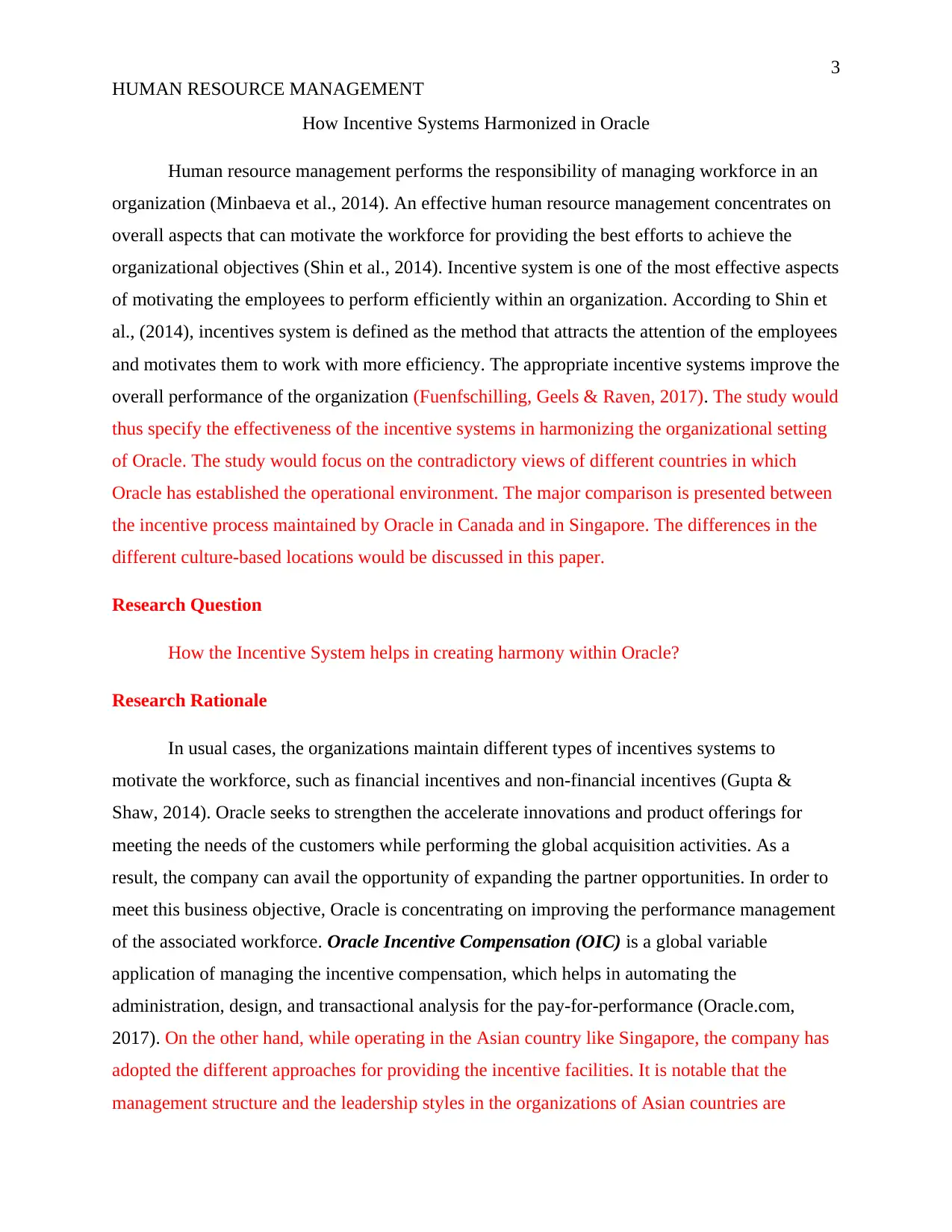
3
HUMAN RESOURCE MANAGEMENT
How Incentive Systems Harmonized in Oracle
Human resource management performs the responsibility of managing workforce in an
organization (Minbaeva et al., 2014). An effective human resource management concentrates on
overall aspects that can motivate the workforce for providing the best efforts to achieve the
organizational objectives (Shin et al., 2014). Incentive system is one of the most effective aspects
of motivating the employees to perform efficiently within an organization. According to Shin et
al., (2014), incentives system is defined as the method that attracts the attention of the employees
and motivates them to work with more efficiency. The appropriate incentive systems improve the
overall performance of the organization (Fuenfschilling, Geels & Raven, 2017). The study would
thus specify the effectiveness of the incentive systems in harmonizing the organizational setting
of Oracle. The study would focus on the contradictory views of different countries in which
Oracle has established the operational environment. The major comparison is presented between
the incentive process maintained by Oracle in Canada and in Singapore. The differences in the
different culture-based locations would be discussed in this paper.
Research Question
How the Incentive System helps in creating harmony within Oracle?
Research Rationale
In usual cases, the organizations maintain different types of incentives systems to
motivate the workforce, such as financial incentives and non-financial incentives (Gupta &
Shaw, 2014). Oracle seeks to strengthen the accelerate innovations and product offerings for
meeting the needs of the customers while performing the global acquisition activities. As a
result, the company can avail the opportunity of expanding the partner opportunities. In order to
meet this business objective, Oracle is concentrating on improving the performance management
of the associated workforce. Oracle Incentive Compensation (OIC) is a global variable
application of managing the incentive compensation, which helps in automating the
administration, design, and transactional analysis for the pay-for-performance (Oracle.com,
2017). On the other hand, while operating in the Asian country like Singapore, the company has
adopted the different approaches for providing the incentive facilities. It is notable that the
management structure and the leadership styles in the organizations of Asian countries are
HUMAN RESOURCE MANAGEMENT
How Incentive Systems Harmonized in Oracle
Human resource management performs the responsibility of managing workforce in an
organization (Minbaeva et al., 2014). An effective human resource management concentrates on
overall aspects that can motivate the workforce for providing the best efforts to achieve the
organizational objectives (Shin et al., 2014). Incentive system is one of the most effective aspects
of motivating the employees to perform efficiently within an organization. According to Shin et
al., (2014), incentives system is defined as the method that attracts the attention of the employees
and motivates them to work with more efficiency. The appropriate incentive systems improve the
overall performance of the organization (Fuenfschilling, Geels & Raven, 2017). The study would
thus specify the effectiveness of the incentive systems in harmonizing the organizational setting
of Oracle. The study would focus on the contradictory views of different countries in which
Oracle has established the operational environment. The major comparison is presented between
the incentive process maintained by Oracle in Canada and in Singapore. The differences in the
different culture-based locations would be discussed in this paper.
Research Question
How the Incentive System helps in creating harmony within Oracle?
Research Rationale
In usual cases, the organizations maintain different types of incentives systems to
motivate the workforce, such as financial incentives and non-financial incentives (Gupta &
Shaw, 2014). Oracle seeks to strengthen the accelerate innovations and product offerings for
meeting the needs of the customers while performing the global acquisition activities. As a
result, the company can avail the opportunity of expanding the partner opportunities. In order to
meet this business objective, Oracle is concentrating on improving the performance management
of the associated workforce. Oracle Incentive Compensation (OIC) is a global variable
application of managing the incentive compensation, which helps in automating the
administration, design, and transactional analysis for the pay-for-performance (Oracle.com,
2017). On the other hand, while operating in the Asian country like Singapore, the company has
adopted the different approaches for providing the incentive facilities. It is notable that the
management structure and the leadership styles in the organizations of Asian countries are
Paraphrase This Document
Need a fresh take? Get an instant paraphrase of this document with our AI Paraphraser
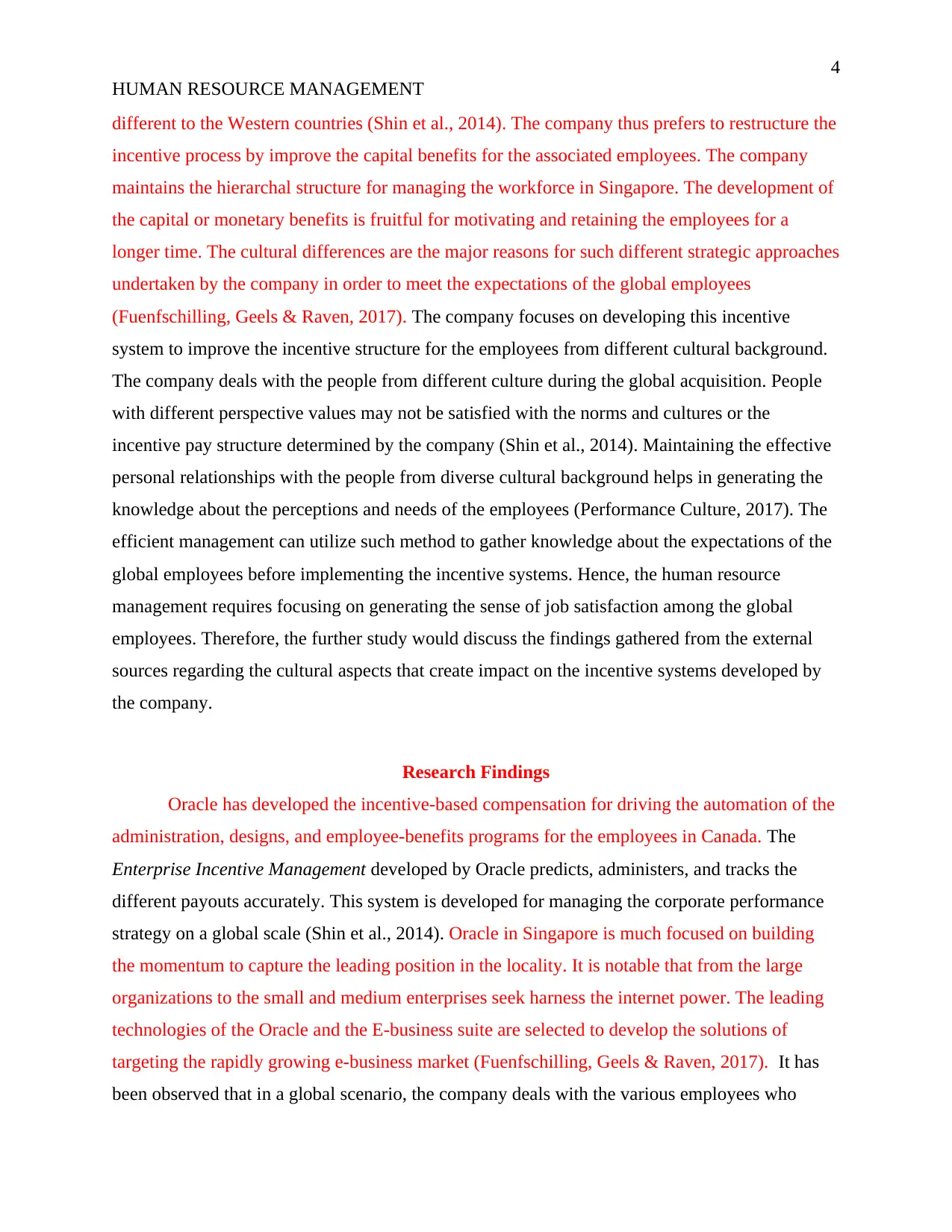
4
HUMAN RESOURCE MANAGEMENT
different to the Western countries (Shin et al., 2014). The company thus prefers to restructure the
incentive process by improve the capital benefits for the associated employees. The company
maintains the hierarchal structure for managing the workforce in Singapore. The development of
the capital or monetary benefits is fruitful for motivating and retaining the employees for a
longer time. The cultural differences are the major reasons for such different strategic approaches
undertaken by the company in order to meet the expectations of the global employees
(Fuenfschilling, Geels & Raven, 2017). The company focuses on developing this incentive
system to improve the incentive structure for the employees from different cultural background.
The company deals with the people from different culture during the global acquisition. People
with different perspective values may not be satisfied with the norms and cultures or the
incentive pay structure determined by the company (Shin et al., 2014). Maintaining the effective
personal relationships with the people from diverse cultural background helps in generating the
knowledge about the perceptions and needs of the employees (Performance Culture, 2017). The
efficient management can utilize such method to gather knowledge about the expectations of the
global employees before implementing the incentive systems. Hence, the human resource
management requires focusing on generating the sense of job satisfaction among the global
employees. Therefore, the further study would discuss the findings gathered from the external
sources regarding the cultural aspects that create impact on the incentive systems developed by
the company.
Research Findings
Oracle has developed the incentive-based compensation for driving the automation of the
administration, designs, and employee-benefits programs for the employees in Canada. The
Enterprise Incentive Management developed by Oracle predicts, administers, and tracks the
different payouts accurately. This system is developed for managing the corporate performance
strategy on a global scale (Shin et al., 2014). Oracle in Singapore is much focused on building
the momentum to capture the leading position in the locality. It is notable that from the large
organizations to the small and medium enterprises seek harness the internet power. The leading
technologies of the Oracle and the E-business suite are selected to develop the solutions of
targeting the rapidly growing e-business market (Fuenfschilling, Geels & Raven, 2017). It has
been observed that in a global scenario, the company deals with the various employees who
HUMAN RESOURCE MANAGEMENT
different to the Western countries (Shin et al., 2014). The company thus prefers to restructure the
incentive process by improve the capital benefits for the associated employees. The company
maintains the hierarchal structure for managing the workforce in Singapore. The development of
the capital or monetary benefits is fruitful for motivating and retaining the employees for a
longer time. The cultural differences are the major reasons for such different strategic approaches
undertaken by the company in order to meet the expectations of the global employees
(Fuenfschilling, Geels & Raven, 2017). The company focuses on developing this incentive
system to improve the incentive structure for the employees from different cultural background.
The company deals with the people from different culture during the global acquisition. People
with different perspective values may not be satisfied with the norms and cultures or the
incentive pay structure determined by the company (Shin et al., 2014). Maintaining the effective
personal relationships with the people from diverse cultural background helps in generating the
knowledge about the perceptions and needs of the employees (Performance Culture, 2017). The
efficient management can utilize such method to gather knowledge about the expectations of the
global employees before implementing the incentive systems. Hence, the human resource
management requires focusing on generating the sense of job satisfaction among the global
employees. Therefore, the further study would discuss the findings gathered from the external
sources regarding the cultural aspects that create impact on the incentive systems developed by
the company.
Research Findings
Oracle has developed the incentive-based compensation for driving the automation of the
administration, designs, and employee-benefits programs for the employees in Canada. The
Enterprise Incentive Management developed by Oracle predicts, administers, and tracks the
different payouts accurately. This system is developed for managing the corporate performance
strategy on a global scale (Shin et al., 2014). Oracle in Singapore is much focused on building
the momentum to capture the leading position in the locality. It is notable that from the large
organizations to the small and medium enterprises seek harness the internet power. The leading
technologies of the Oracle and the E-business suite are selected to develop the solutions of
targeting the rapidly growing e-business market (Fuenfschilling, Geels & Raven, 2017). It has
been observed that in a global scenario, the company deals with the various employees who
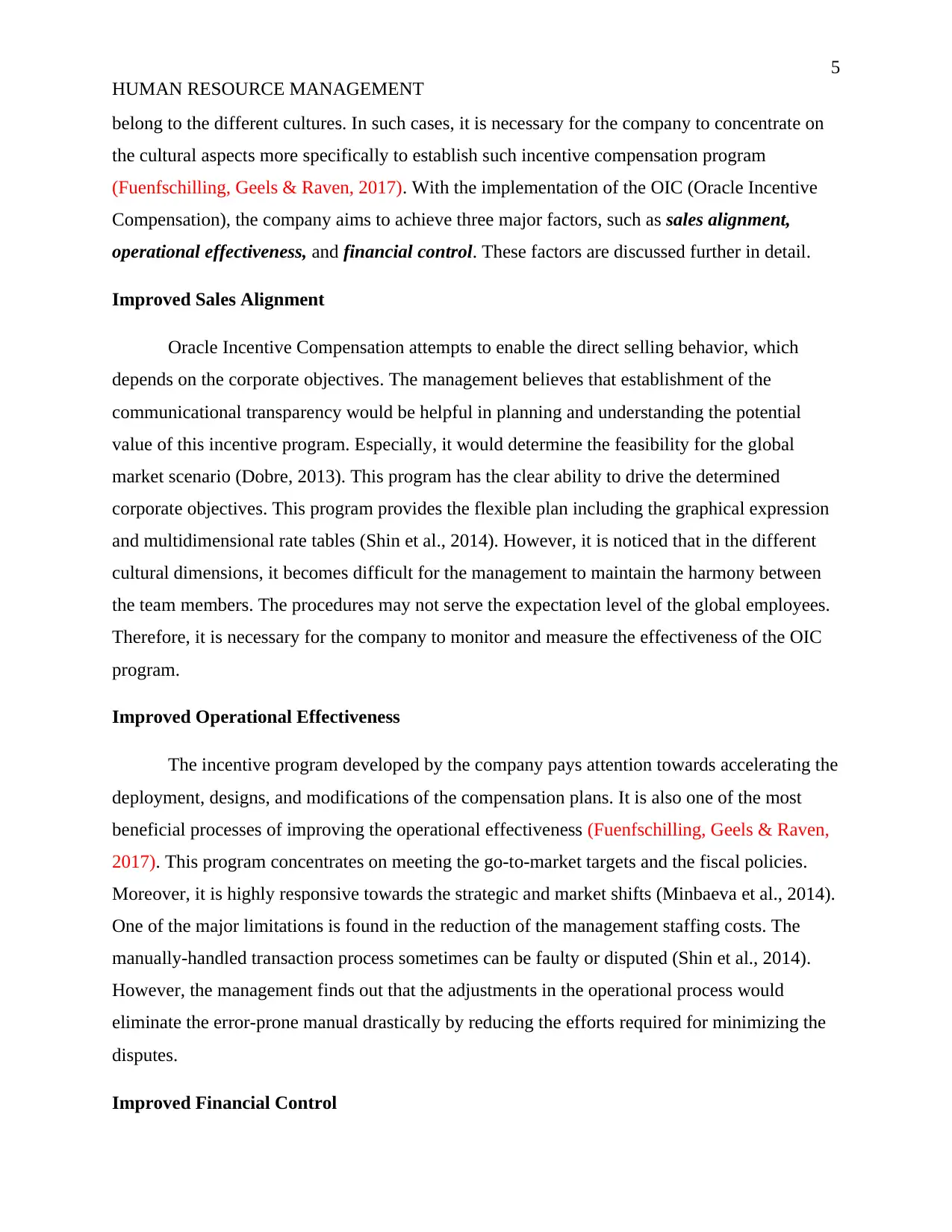
5
HUMAN RESOURCE MANAGEMENT
belong to the different cultures. In such cases, it is necessary for the company to concentrate on
the cultural aspects more specifically to establish such incentive compensation program
(Fuenfschilling, Geels & Raven, 2017). With the implementation of the OIC (Oracle Incentive
Compensation), the company aims to achieve three major factors, such as sales alignment,
operational effectiveness, and financial control. These factors are discussed further in detail.
Improved Sales Alignment
Oracle Incentive Compensation attempts to enable the direct selling behavior, which
depends on the corporate objectives. The management believes that establishment of the
communicational transparency would be helpful in planning and understanding the potential
value of this incentive program. Especially, it would determine the feasibility for the global
market scenario (Dobre, 2013). This program has the clear ability to drive the determined
corporate objectives. This program provides the flexible plan including the graphical expression
and multidimensional rate tables (Shin et al., 2014). However, it is noticed that in the different
cultural dimensions, it becomes difficult for the management to maintain the harmony between
the team members. The procedures may not serve the expectation level of the global employees.
Therefore, it is necessary for the company to monitor and measure the effectiveness of the OIC
program.
Improved Operational Effectiveness
The incentive program developed by the company pays attention towards accelerating the
deployment, designs, and modifications of the compensation plans. It is also one of the most
beneficial processes of improving the operational effectiveness (Fuenfschilling, Geels & Raven,
2017). This program concentrates on meeting the go-to-market targets and the fiscal policies.
Moreover, it is highly responsive towards the strategic and market shifts (Minbaeva et al., 2014).
One of the major limitations is found in the reduction of the management staffing costs. The
manually-handled transaction process sometimes can be faulty or disputed (Shin et al., 2014).
However, the management finds out that the adjustments in the operational process would
eliminate the error-prone manual drastically by reducing the efforts required for minimizing the
disputes.
Improved Financial Control
HUMAN RESOURCE MANAGEMENT
belong to the different cultures. In such cases, it is necessary for the company to concentrate on
the cultural aspects more specifically to establish such incentive compensation program
(Fuenfschilling, Geels & Raven, 2017). With the implementation of the OIC (Oracle Incentive
Compensation), the company aims to achieve three major factors, such as sales alignment,
operational effectiveness, and financial control. These factors are discussed further in detail.
Improved Sales Alignment
Oracle Incentive Compensation attempts to enable the direct selling behavior, which
depends on the corporate objectives. The management believes that establishment of the
communicational transparency would be helpful in planning and understanding the potential
value of this incentive program. Especially, it would determine the feasibility for the global
market scenario (Dobre, 2013). This program has the clear ability to drive the determined
corporate objectives. This program provides the flexible plan including the graphical expression
and multidimensional rate tables (Shin et al., 2014). However, it is noticed that in the different
cultural dimensions, it becomes difficult for the management to maintain the harmony between
the team members. The procedures may not serve the expectation level of the global employees.
Therefore, it is necessary for the company to monitor and measure the effectiveness of the OIC
program.
Improved Operational Effectiveness
The incentive program developed by the company pays attention towards accelerating the
deployment, designs, and modifications of the compensation plans. It is also one of the most
beneficial processes of improving the operational effectiveness (Fuenfschilling, Geels & Raven,
2017). This program concentrates on meeting the go-to-market targets and the fiscal policies.
Moreover, it is highly responsive towards the strategic and market shifts (Minbaeva et al., 2014).
One of the major limitations is found in the reduction of the management staffing costs. The
manually-handled transaction process sometimes can be faulty or disputed (Shin et al., 2014).
However, the management finds out that the adjustments in the operational process would
eliminate the error-prone manual drastically by reducing the efforts required for minimizing the
disputes.
Improved Financial Control
⊘ This is a preview!⊘
Do you want full access?
Subscribe today to unlock all pages.

Trusted by 1+ million students worldwide
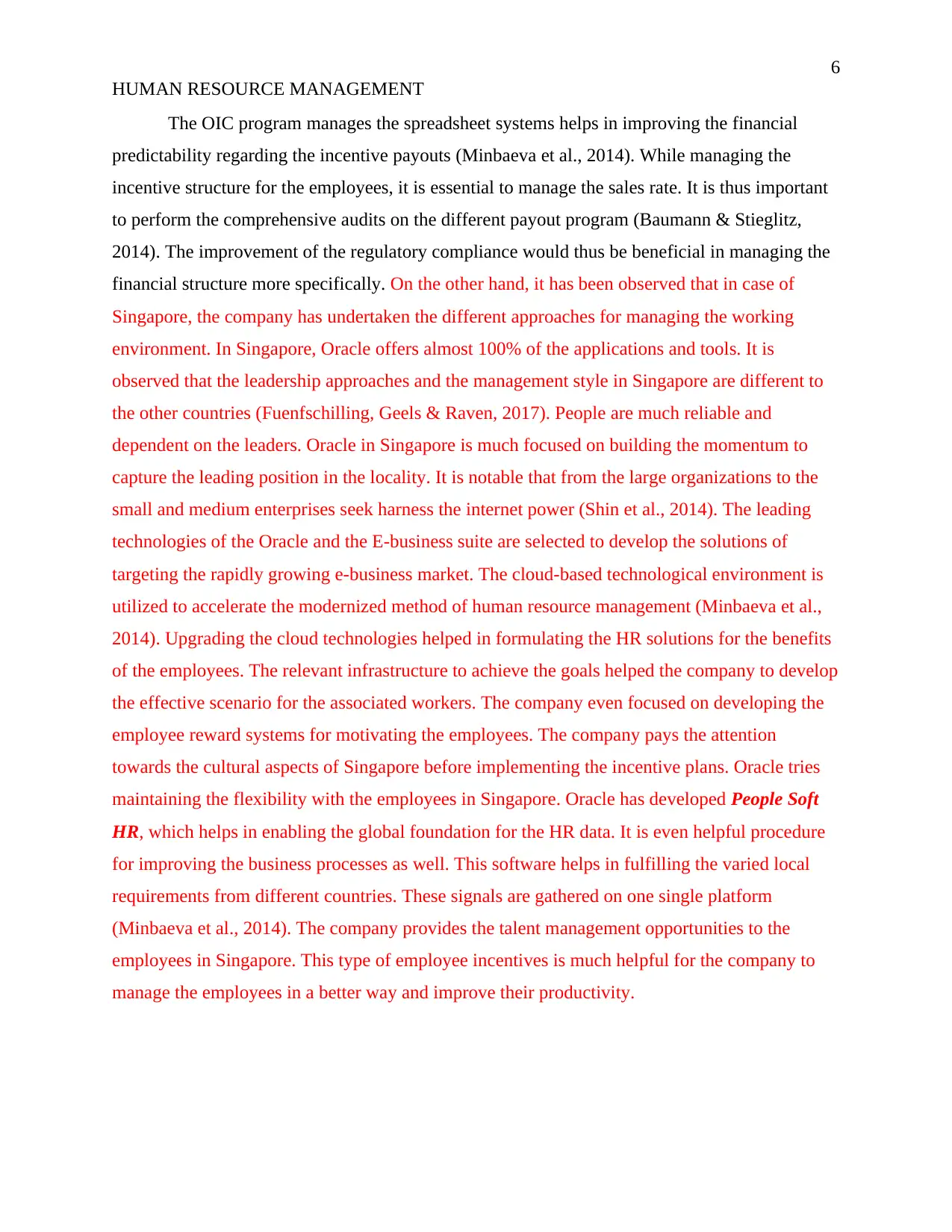
6
HUMAN RESOURCE MANAGEMENT
The OIC program manages the spreadsheet systems helps in improving the financial
predictability regarding the incentive payouts (Minbaeva et al., 2014). While managing the
incentive structure for the employees, it is essential to manage the sales rate. It is thus important
to perform the comprehensive audits on the different payout program (Baumann & Stieglitz,
2014). The improvement of the regulatory compliance would thus be beneficial in managing the
financial structure more specifically. On the other hand, it has been observed that in case of
Singapore, the company has undertaken the different approaches for managing the working
environment. In Singapore, Oracle offers almost 100% of the applications and tools. It is
observed that the leadership approaches and the management style in Singapore are different to
the other countries (Fuenfschilling, Geels & Raven, 2017). People are much reliable and
dependent on the leaders. Oracle in Singapore is much focused on building the momentum to
capture the leading position in the locality. It is notable that from the large organizations to the
small and medium enterprises seek harness the internet power (Shin et al., 2014). The leading
technologies of the Oracle and the E-business suite are selected to develop the solutions of
targeting the rapidly growing e-business market. The cloud-based technological environment is
utilized to accelerate the modernized method of human resource management (Minbaeva et al.,
2014). Upgrading the cloud technologies helped in formulating the HR solutions for the benefits
of the employees. The relevant infrastructure to achieve the goals helped the company to develop
the effective scenario for the associated workers. The company even focused on developing the
employee reward systems for motivating the employees. The company pays the attention
towards the cultural aspects of Singapore before implementing the incentive plans. Oracle tries
maintaining the flexibility with the employees in Singapore. Oracle has developed People Soft
HR, which helps in enabling the global foundation for the HR data. It is even helpful procedure
for improving the business processes as well. This software helps in fulfilling the varied local
requirements from different countries. These signals are gathered on one single platform
(Minbaeva et al., 2014). The company provides the talent management opportunities to the
employees in Singapore. This type of employee incentives is much helpful for the company to
manage the employees in a better way and improve their productivity.
HUMAN RESOURCE MANAGEMENT
The OIC program manages the spreadsheet systems helps in improving the financial
predictability regarding the incentive payouts (Minbaeva et al., 2014). While managing the
incentive structure for the employees, it is essential to manage the sales rate. It is thus important
to perform the comprehensive audits on the different payout program (Baumann & Stieglitz,
2014). The improvement of the regulatory compliance would thus be beneficial in managing the
financial structure more specifically. On the other hand, it has been observed that in case of
Singapore, the company has undertaken the different approaches for managing the working
environment. In Singapore, Oracle offers almost 100% of the applications and tools. It is
observed that the leadership approaches and the management style in Singapore are different to
the other countries (Fuenfschilling, Geels & Raven, 2017). People are much reliable and
dependent on the leaders. Oracle in Singapore is much focused on building the momentum to
capture the leading position in the locality. It is notable that from the large organizations to the
small and medium enterprises seek harness the internet power (Shin et al., 2014). The leading
technologies of the Oracle and the E-business suite are selected to develop the solutions of
targeting the rapidly growing e-business market. The cloud-based technological environment is
utilized to accelerate the modernized method of human resource management (Minbaeva et al.,
2014). Upgrading the cloud technologies helped in formulating the HR solutions for the benefits
of the employees. The relevant infrastructure to achieve the goals helped the company to develop
the effective scenario for the associated workers. The company even focused on developing the
employee reward systems for motivating the employees. The company pays the attention
towards the cultural aspects of Singapore before implementing the incentive plans. Oracle tries
maintaining the flexibility with the employees in Singapore. Oracle has developed People Soft
HR, which helps in enabling the global foundation for the HR data. It is even helpful procedure
for improving the business processes as well. This software helps in fulfilling the varied local
requirements from different countries. These signals are gathered on one single platform
(Minbaeva et al., 2014). The company provides the talent management opportunities to the
employees in Singapore. This type of employee incentives is much helpful for the company to
manage the employees in a better way and improve their productivity.
Paraphrase This Document
Need a fresh take? Get an instant paraphrase of this document with our AI Paraphraser
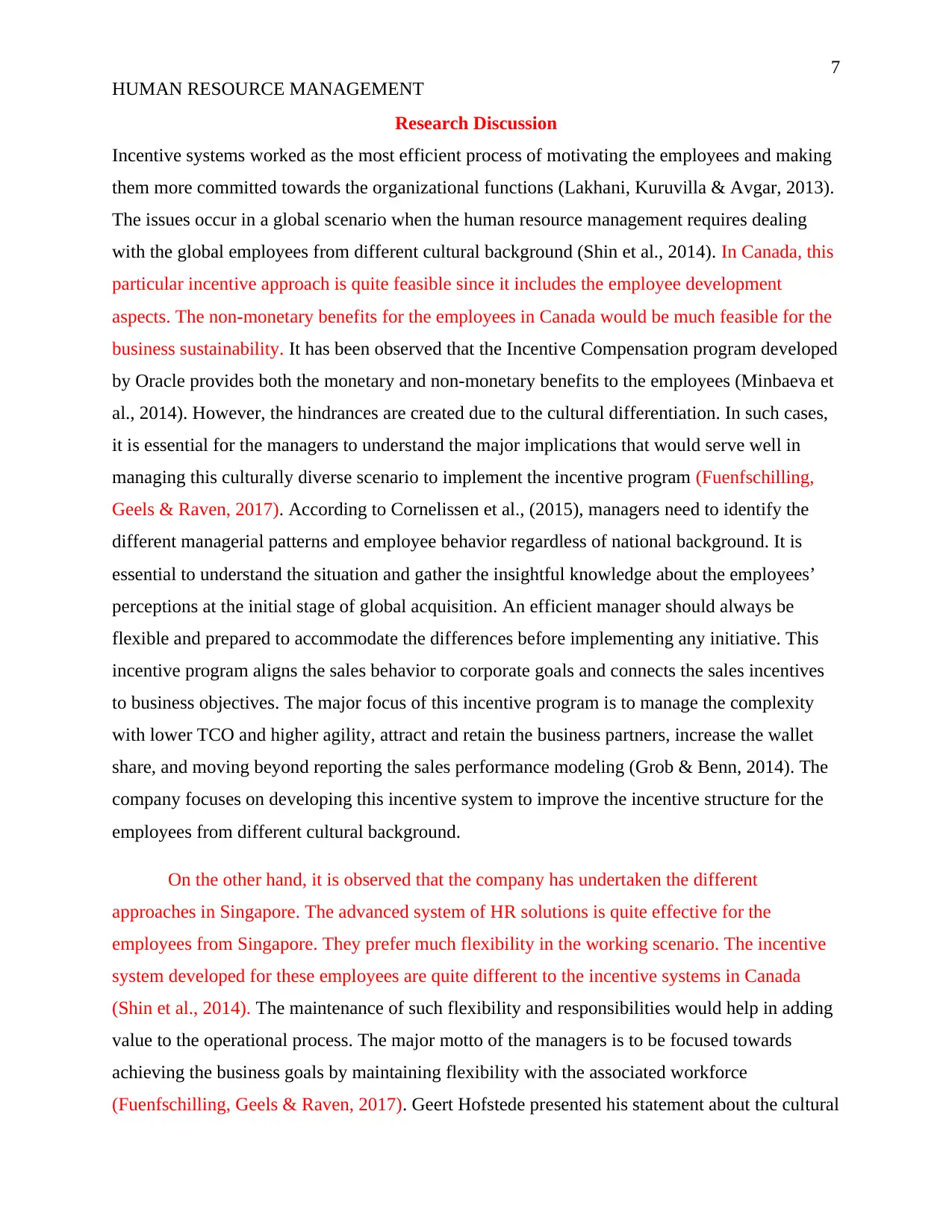
7
HUMAN RESOURCE MANAGEMENT
Research Discussion
Incentive systems worked as the most efficient process of motivating the employees and making
them more committed towards the organizational functions (Lakhani, Kuruvilla & Avgar, 2013).
The issues occur in a global scenario when the human resource management requires dealing
with the global employees from different cultural background (Shin et al., 2014). In Canada, this
particular incentive approach is quite feasible since it includes the employee development
aspects. The non-monetary benefits for the employees in Canada would be much feasible for the
business sustainability. It has been observed that the Incentive Compensation program developed
by Oracle provides both the monetary and non-monetary benefits to the employees (Minbaeva et
al., 2014). However, the hindrances are created due to the cultural differentiation. In such cases,
it is essential for the managers to understand the major implications that would serve well in
managing this culturally diverse scenario to implement the incentive program (Fuenfschilling,
Geels & Raven, 2017). According to Cornelissen et al., (2015), managers need to identify the
different managerial patterns and employee behavior regardless of national background. It is
essential to understand the situation and gather the insightful knowledge about the employees’
perceptions at the initial stage of global acquisition. An efficient manager should always be
flexible and prepared to accommodate the differences before implementing any initiative. This
incentive program aligns the sales behavior to corporate goals and connects the sales incentives
to business objectives. The major focus of this incentive program is to manage the complexity
with lower TCO and higher agility, attract and retain the business partners, increase the wallet
share, and moving beyond reporting the sales performance modeling (Grob & Benn, 2014). The
company focuses on developing this incentive system to improve the incentive structure for the
employees from different cultural background.
On the other hand, it is observed that the company has undertaken the different
approaches in Singapore. The advanced system of HR solutions is quite effective for the
employees from Singapore. They prefer much flexibility in the working scenario. The incentive
system developed for these employees are quite different to the incentive systems in Canada
(Shin et al., 2014). The maintenance of such flexibility and responsibilities would help in adding
value to the operational process. The major motto of the managers is to be focused towards
achieving the business goals by maintaining flexibility with the associated workforce
(Fuenfschilling, Geels & Raven, 2017). Geert Hofstede presented his statement about the cultural
HUMAN RESOURCE MANAGEMENT
Research Discussion
Incentive systems worked as the most efficient process of motivating the employees and making
them more committed towards the organizational functions (Lakhani, Kuruvilla & Avgar, 2013).
The issues occur in a global scenario when the human resource management requires dealing
with the global employees from different cultural background (Shin et al., 2014). In Canada, this
particular incentive approach is quite feasible since it includes the employee development
aspects. The non-monetary benefits for the employees in Canada would be much feasible for the
business sustainability. It has been observed that the Incentive Compensation program developed
by Oracle provides both the monetary and non-monetary benefits to the employees (Minbaeva et
al., 2014). However, the hindrances are created due to the cultural differentiation. In such cases,
it is essential for the managers to understand the major implications that would serve well in
managing this culturally diverse scenario to implement the incentive program (Fuenfschilling,
Geels & Raven, 2017). According to Cornelissen et al., (2015), managers need to identify the
different managerial patterns and employee behavior regardless of national background. It is
essential to understand the situation and gather the insightful knowledge about the employees’
perceptions at the initial stage of global acquisition. An efficient manager should always be
flexible and prepared to accommodate the differences before implementing any initiative. This
incentive program aligns the sales behavior to corporate goals and connects the sales incentives
to business objectives. The major focus of this incentive program is to manage the complexity
with lower TCO and higher agility, attract and retain the business partners, increase the wallet
share, and moving beyond reporting the sales performance modeling (Grob & Benn, 2014). The
company focuses on developing this incentive system to improve the incentive structure for the
employees from different cultural background.
On the other hand, it is observed that the company has undertaken the different
approaches in Singapore. The advanced system of HR solutions is quite effective for the
employees from Singapore. They prefer much flexibility in the working scenario. The incentive
system developed for these employees are quite different to the incentive systems in Canada
(Shin et al., 2014). The maintenance of such flexibility and responsibilities would help in adding
value to the operational process. The major motto of the managers is to be focused towards
achieving the business goals by maintaining flexibility with the associated workforce
(Fuenfschilling, Geels & Raven, 2017). Geert Hofstede presented his statement about the cultural
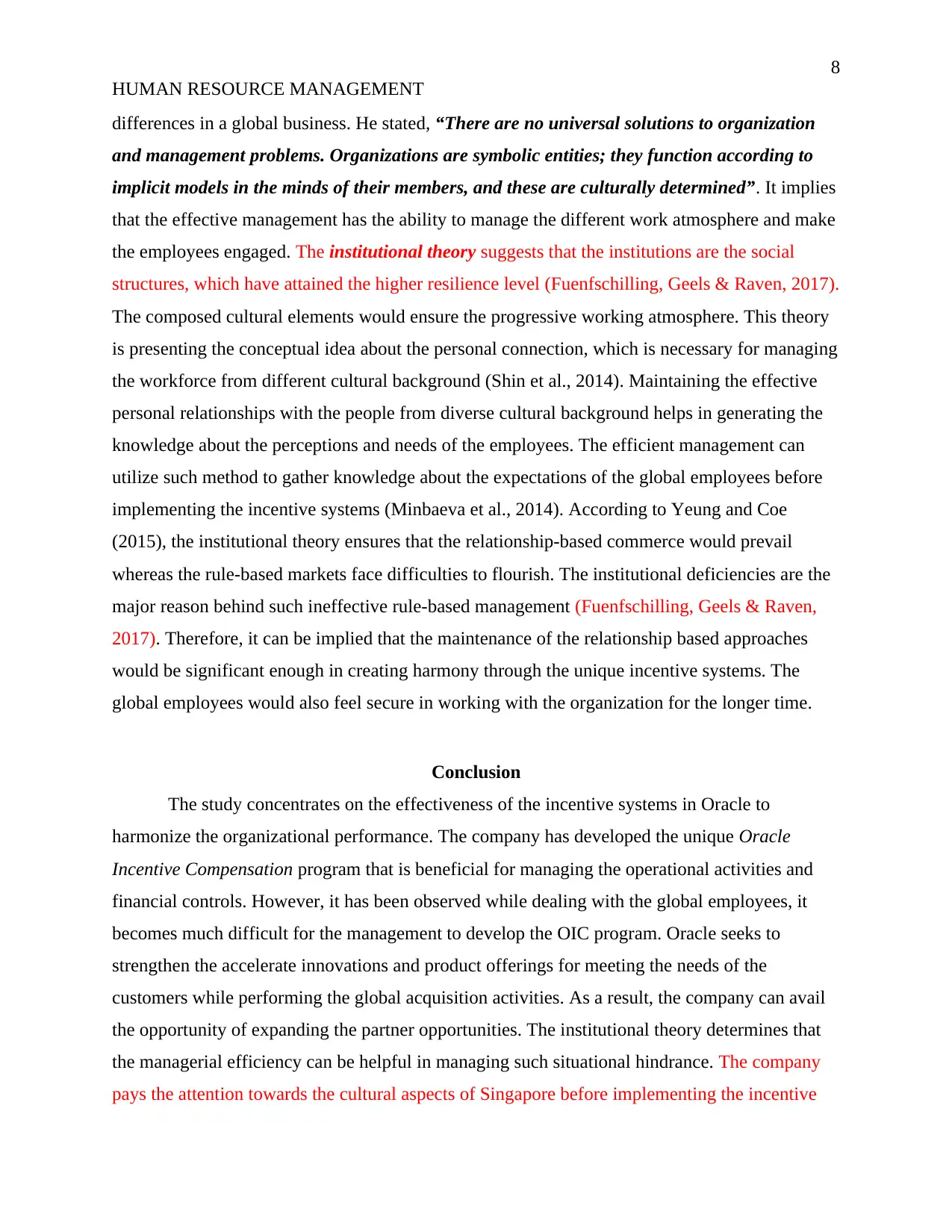
8
HUMAN RESOURCE MANAGEMENT
differences in a global business. He stated, “There are no universal solutions to organization
and management problems. Organizations are symbolic entities; they function according to
implicit models in the minds of their members, and these are culturally determined”. It implies
that the effective management has the ability to manage the different work atmosphere and make
the employees engaged. The institutional theory suggests that the institutions are the social
structures, which have attained the higher resilience level (Fuenfschilling, Geels & Raven, 2017).
The composed cultural elements would ensure the progressive working atmosphere. This theory
is presenting the conceptual idea about the personal connection, which is necessary for managing
the workforce from different cultural background (Shin et al., 2014). Maintaining the effective
personal relationships with the people from diverse cultural background helps in generating the
knowledge about the perceptions and needs of the employees. The efficient management can
utilize such method to gather knowledge about the expectations of the global employees before
implementing the incentive systems (Minbaeva et al., 2014). According to Yeung and Coe
(2015), the institutional theory ensures that the relationship-based commerce would prevail
whereas the rule-based markets face difficulties to flourish. The institutional deficiencies are the
major reason behind such ineffective rule-based management (Fuenfschilling, Geels & Raven,
2017). Therefore, it can be implied that the maintenance of the relationship based approaches
would be significant enough in creating harmony through the unique incentive systems. The
global employees would also feel secure in working with the organization for the longer time.
Conclusion
The study concentrates on the effectiveness of the incentive systems in Oracle to
harmonize the organizational performance. The company has developed the unique Oracle
Incentive Compensation program that is beneficial for managing the operational activities and
financial controls. However, it has been observed while dealing with the global employees, it
becomes much difficult for the management to develop the OIC program. Oracle seeks to
strengthen the accelerate innovations and product offerings for meeting the needs of the
customers while performing the global acquisition activities. As a result, the company can avail
the opportunity of expanding the partner opportunities. The institutional theory determines that
the managerial efficiency can be helpful in managing such situational hindrance. The company
pays the attention towards the cultural aspects of Singapore before implementing the incentive
HUMAN RESOURCE MANAGEMENT
differences in a global business. He stated, “There are no universal solutions to organization
and management problems. Organizations are symbolic entities; they function according to
implicit models in the minds of their members, and these are culturally determined”. It implies
that the effective management has the ability to manage the different work atmosphere and make
the employees engaged. The institutional theory suggests that the institutions are the social
structures, which have attained the higher resilience level (Fuenfschilling, Geels & Raven, 2017).
The composed cultural elements would ensure the progressive working atmosphere. This theory
is presenting the conceptual idea about the personal connection, which is necessary for managing
the workforce from different cultural background (Shin et al., 2014). Maintaining the effective
personal relationships with the people from diverse cultural background helps in generating the
knowledge about the perceptions and needs of the employees. The efficient management can
utilize such method to gather knowledge about the expectations of the global employees before
implementing the incentive systems (Minbaeva et al., 2014). According to Yeung and Coe
(2015), the institutional theory ensures that the relationship-based commerce would prevail
whereas the rule-based markets face difficulties to flourish. The institutional deficiencies are the
major reason behind such ineffective rule-based management (Fuenfschilling, Geels & Raven,
2017). Therefore, it can be implied that the maintenance of the relationship based approaches
would be significant enough in creating harmony through the unique incentive systems. The
global employees would also feel secure in working with the organization for the longer time.
Conclusion
The study concentrates on the effectiveness of the incentive systems in Oracle to
harmonize the organizational performance. The company has developed the unique Oracle
Incentive Compensation program that is beneficial for managing the operational activities and
financial controls. However, it has been observed while dealing with the global employees, it
becomes much difficult for the management to develop the OIC program. Oracle seeks to
strengthen the accelerate innovations and product offerings for meeting the needs of the
customers while performing the global acquisition activities. As a result, the company can avail
the opportunity of expanding the partner opportunities. The institutional theory determines that
the managerial efficiency can be helpful in managing such situational hindrance. The company
pays the attention towards the cultural aspects of Singapore before implementing the incentive
⊘ This is a preview!⊘
Do you want full access?
Subscribe today to unlock all pages.

Trusted by 1+ million students worldwide
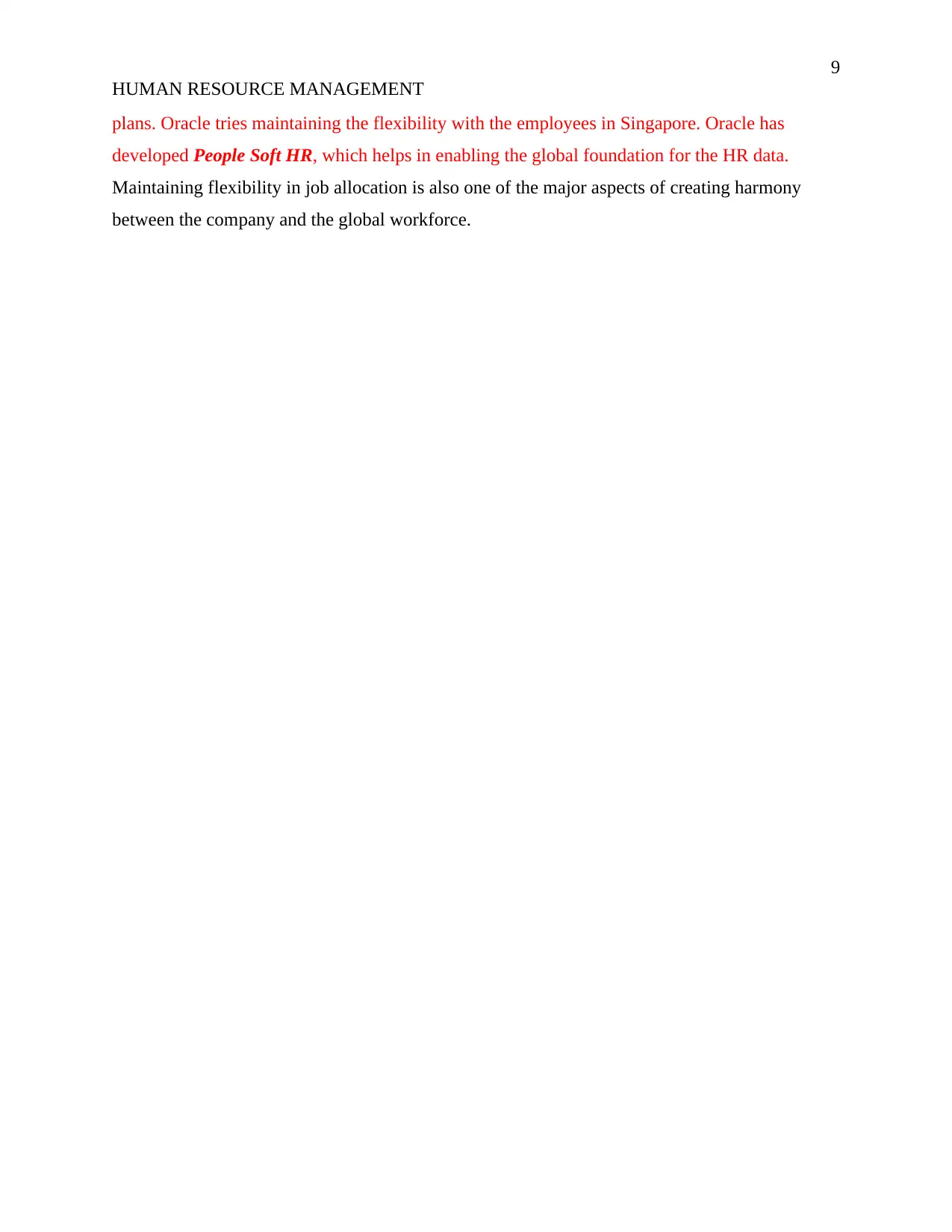
9
HUMAN RESOURCE MANAGEMENT
plans. Oracle tries maintaining the flexibility with the employees in Singapore. Oracle has
developed People Soft HR, which helps in enabling the global foundation for the HR data.
Maintaining flexibility in job allocation is also one of the major aspects of creating harmony
between the company and the global workforce.
HUMAN RESOURCE MANAGEMENT
plans. Oracle tries maintaining the flexibility with the employees in Singapore. Oracle has
developed People Soft HR, which helps in enabling the global foundation for the HR data.
Maintaining flexibility in job allocation is also one of the major aspects of creating harmony
between the company and the global workforce.
Paraphrase This Document
Need a fresh take? Get an instant paraphrase of this document with our AI Paraphraser
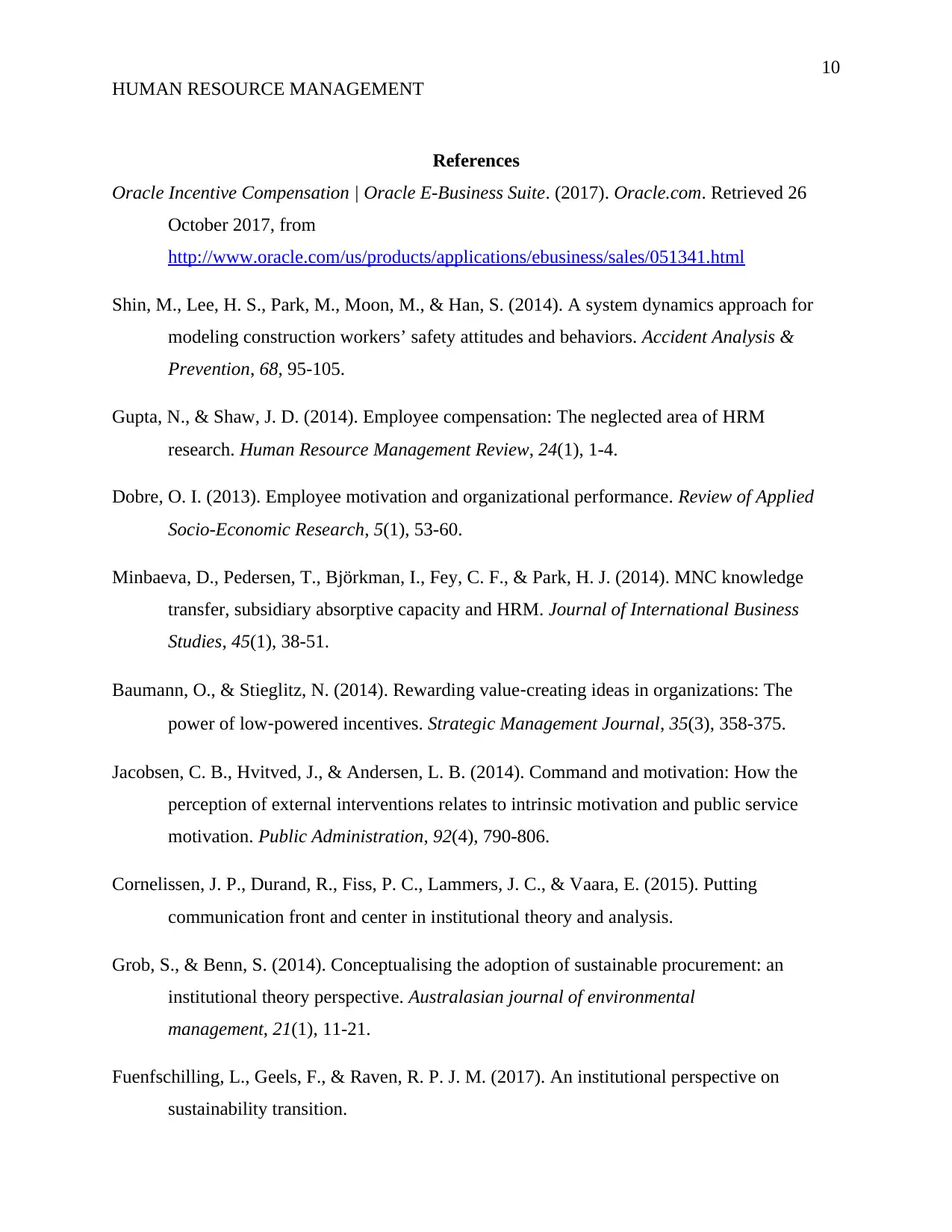
10
HUMAN RESOURCE MANAGEMENT
References
Oracle Incentive Compensation | Oracle E-Business Suite. (2017). Oracle.com. Retrieved 26
October 2017, from
http://www.oracle.com/us/products/applications/ebusiness/sales/051341.html
Shin, M., Lee, H. S., Park, M., Moon, M., & Han, S. (2014). A system dynamics approach for
modeling construction workers’ safety attitudes and behaviors. Accident Analysis &
Prevention, 68, 95-105.
Gupta, N., & Shaw, J. D. (2014). Employee compensation: The neglected area of HRM
research. Human Resource Management Review, 24(1), 1-4.
Dobre, O. I. (2013). Employee motivation and organizational performance. Review of Applied
Socio-Economic Research, 5(1), 53-60.
Minbaeva, D., Pedersen, T., Björkman, I., Fey, C. F., & Park, H. J. (2014). MNC knowledge
transfer, subsidiary absorptive capacity and HRM. Journal of International Business
Studies, 45(1), 38-51.
Baumann, O., & Stieglitz, N. (2014). Rewarding value‐creating ideas in organizations: The
power of low‐powered incentives. Strategic Management Journal, 35(3), 358-375.
Jacobsen, C. B., Hvitved, J., & Andersen, L. B. (2014). Command and motivation: How the
perception of external interventions relates to intrinsic motivation and public service
motivation. Public Administration, 92(4), 790-806.
Cornelissen, J. P., Durand, R., Fiss, P. C., Lammers, J. C., & Vaara, E. (2015). Putting
communication front and center in institutional theory and analysis.
Grob, S., & Benn, S. (2014). Conceptualising the adoption of sustainable procurement: an
institutional theory perspective. Australasian journal of environmental
management, 21(1), 11-21.
Fuenfschilling, L., Geels, F., & Raven, R. P. J. M. (2017). An institutional perspective on
sustainability transition.
HUMAN RESOURCE MANAGEMENT
References
Oracle Incentive Compensation | Oracle E-Business Suite. (2017). Oracle.com. Retrieved 26
October 2017, from
http://www.oracle.com/us/products/applications/ebusiness/sales/051341.html
Shin, M., Lee, H. S., Park, M., Moon, M., & Han, S. (2014). A system dynamics approach for
modeling construction workers’ safety attitudes and behaviors. Accident Analysis &
Prevention, 68, 95-105.
Gupta, N., & Shaw, J. D. (2014). Employee compensation: The neglected area of HRM
research. Human Resource Management Review, 24(1), 1-4.
Dobre, O. I. (2013). Employee motivation and organizational performance. Review of Applied
Socio-Economic Research, 5(1), 53-60.
Minbaeva, D., Pedersen, T., Björkman, I., Fey, C. F., & Park, H. J. (2014). MNC knowledge
transfer, subsidiary absorptive capacity and HRM. Journal of International Business
Studies, 45(1), 38-51.
Baumann, O., & Stieglitz, N. (2014). Rewarding value‐creating ideas in organizations: The
power of low‐powered incentives. Strategic Management Journal, 35(3), 358-375.
Jacobsen, C. B., Hvitved, J., & Andersen, L. B. (2014). Command and motivation: How the
perception of external interventions relates to intrinsic motivation and public service
motivation. Public Administration, 92(4), 790-806.
Cornelissen, J. P., Durand, R., Fiss, P. C., Lammers, J. C., & Vaara, E. (2015). Putting
communication front and center in institutional theory and analysis.
Grob, S., & Benn, S. (2014). Conceptualising the adoption of sustainable procurement: an
institutional theory perspective. Australasian journal of environmental
management, 21(1), 11-21.
Fuenfschilling, L., Geels, F., & Raven, R. P. J. M. (2017). An institutional perspective on
sustainability transition.
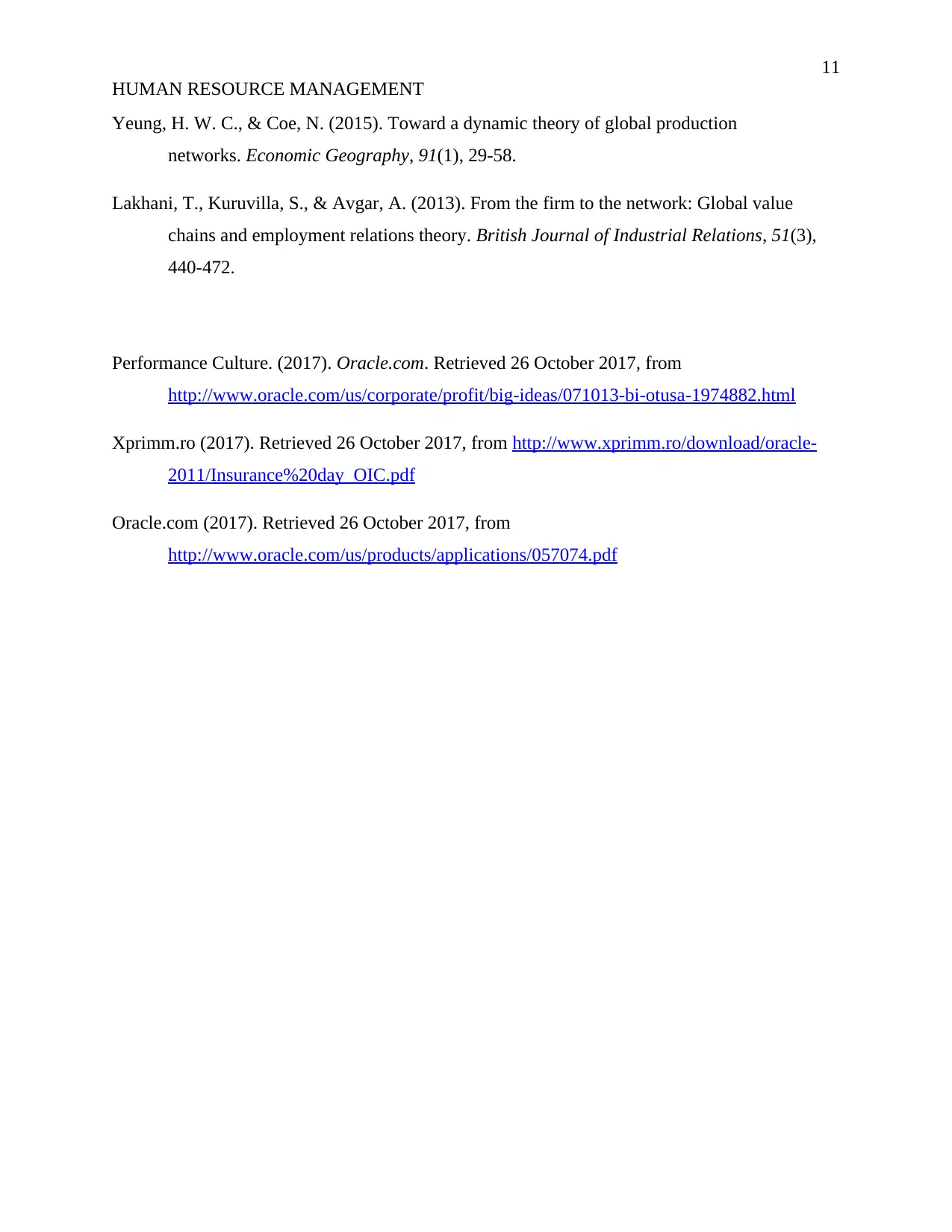
11
HUMAN RESOURCE MANAGEMENT
Yeung, H. W. C., & Coe, N. (2015). Toward a dynamic theory of global production
networks. Economic Geography, 91(1), 29-58.
Lakhani, T., Kuruvilla, S., & Avgar, A. (2013). From the firm to the network: Global value
chains and employment relations theory. British Journal of Industrial Relations, 51(3),
440-472.
Performance Culture. (2017). Oracle.com. Retrieved 26 October 2017, from
http://www.oracle.com/us/corporate/profit/big-ideas/071013-bi-otusa-1974882.html
Xprimm.ro (2017). Retrieved 26 October 2017, from http://www.xprimm.ro/download/oracle-
2011/Insurance%20day_OIC.pdf
Oracle.com (2017). Retrieved 26 October 2017, from
http://www.oracle.com/us/products/applications/057074.pdf
HUMAN RESOURCE MANAGEMENT
Yeung, H. W. C., & Coe, N. (2015). Toward a dynamic theory of global production
networks. Economic Geography, 91(1), 29-58.
Lakhani, T., Kuruvilla, S., & Avgar, A. (2013). From the firm to the network: Global value
chains and employment relations theory. British Journal of Industrial Relations, 51(3),
440-472.
Performance Culture. (2017). Oracle.com. Retrieved 26 October 2017, from
http://www.oracle.com/us/corporate/profit/big-ideas/071013-bi-otusa-1974882.html
Xprimm.ro (2017). Retrieved 26 October 2017, from http://www.xprimm.ro/download/oracle-
2011/Insurance%20day_OIC.pdf
Oracle.com (2017). Retrieved 26 October 2017, from
http://www.oracle.com/us/products/applications/057074.pdf
⊘ This is a preview!⊘
Do you want full access?
Subscribe today to unlock all pages.

Trusted by 1+ million students worldwide
1 out of 12
Related Documents
Your All-in-One AI-Powered Toolkit for Academic Success.
+13062052269
info@desklib.com
Available 24*7 on WhatsApp / Email
![[object Object]](/_next/static/media/star-bottom.7253800d.svg)
Unlock your academic potential
Copyright © 2020–2025 A2Z Services. All Rights Reserved. Developed and managed by ZUCOL.





